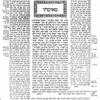4: Image, page of Talmud printed by the Rom Press, 1886.
The imagery of Sutzkever’s poem assumes that readers will be familiar with the Rom Press, one of the largest and most culturally significant Jewish printing presses of the nineteenth century. In addition to a number of minor religious tractates and commentaries, in 1886, the press famously released a 37-volume edition of the Babylonian Talmud, one of the central texts of Judaism.
Sutzkever also assumes that his audience will know something about the Talmud, a text which consists of two elements: the Mishnah, a compilation of Rabbinic laws and traditions written down around 200 CE, and the Gemara, a series of commentaries on the Mishnah published around 500 CE.
Suggested Activities: Have students look at the page of Talmud printed at the Rom Press, paying close attention to the different fonts and placements of words. The Mishnah is in the center, surrounded by centuries of commentaries. Have students consider the third stanza of “The Lead Plates of the Rom Printers,” in which Sutzkever writes, “Ancient thoughts—in the letters that melted hot. / A line from Babylonia, from Poland a line, / Boiled, flooded together, in the foundry pot.” Ask students to consider the literal and metaphorical meanings of these lines, and how they might relate to this image from a Rom Press Talmud. How does this image affect their understanding of the poem? How does it add to the meaning of the lead plates in Sutzkever’s poem?
Source: First page of the first tractate of the Talmud (Daf Bet of Masechet Brachot) (Vilnius: Rom Press, 1886), accessed at https://commons.wikimedia.org/wiki/File:First_page_of_the_first_tractate_of_the_Talmud_(Daf_Beis_of_Maseches_Brachos).jpg on May 15, 2019.
Page of Talmud
 Download image (210.29 KB)
Download image (210.29 KB)

